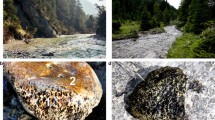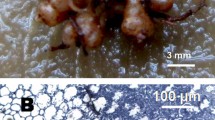Abstract
Relationship among symbiotic dinoflagellates of the genusSymbiodinium derived from seven different host species has been studied by means of DNA/DNA hybridization. DNA homologies range from about 70 to 30%D. Highest homology is regarded as subspecific level. Based on the characteristics of DNA and phenotypes,Symbiodinium microadriaticum subsp.microadriaticum is separated fromSymbiodinium microadriaticum subsp.condylactis. Lowest homology occurs at the methodical background, and is similar to that obtained with DNA of algae belonging to different classes. The data are in excellent agreement with DNA base composition, karyotypes, and morpohological as well as biochemical markers, emphasizing speciation among these gymnodinioid zooxanthellae.
Similar content being viewed by others
References
Allen, J. R., Roberts, T. M., Loeblich, A. R., Klotz, L. C., 1975: Characterization of the DNA from the dinoflagellateCrypthecodinium cohnii and implications for nuclear organization. — Cell6: 161–169.
Blank, R. J., 1986: Unusual chloroplast structures in endosymbiotic dinoflagellates: a clue to evolutionary differentiation within the genusSymbiodinium (Dinophyceae). — Pl. Syst. Evol.151: 271–280.
Blank, R. J., 1987: Cell architecture of the dinoflagellateSymbiodinium sp. inhabiting the Hawaiian stony coralMontipora verrucosa. — Mar. Biol.94: 143–155.
—,Trench, R. K., 1985a: Speciation and symbiotic dinoflagellates. — Science229: 656–658.
—, —, 1985b:Symbiodinium microadriaticum: a single species? — InGabrie, C., Toffart, J. L., Salvat, B., (Eds.): Proceedings of the fifth international coral reef congress (Tahiti)6, pp. 113–117. — Papeete: Antenne du Museum National d'Histoire Naturelle et de l'École Pratique des Hautes Études.
—, —, 1986: Nomenclature of endosymbiotic dinoflagellates. — Taxon35: 286–294.
—,Huss, V. A. R., Kersten, W., 1988: Base composition of DNA from symbiotic dinoflagellates: a tool for phylogenetic classification. — Arch. Microbiol.149: 515–520.
Chang, S. S., Trench, R. K., 1982: Peridinin-chlorophylla-proteins from the symbiotic dinoflagellateSymbiodinium ( =Gymnodinium)microadriaticum Freudenthal. — Proc. Roy. Soc. Lond. (B)215: 191–210.
Flavell, R., O'Dell, M., Smith, D., 1979: Repeated sequence DNA comparisons betweenTriticum andAegilops species. — Heredity42: 309–322.
Freudenthal, H. D., 1962:Symbiodinium gen. nov. andSymbiodinium microadriaticum sp. nov., a zooxanthella: taxonomy, life cycle, and morphology. — J. Protozool.6: 45–52.
Gaffal, K. P., 1987: Mitosis-specific oscillations of mitochondrial morphology inChlamydomonas reinhardii. — Endocyt. C. Res.4: 41–62.
Huss, V. A. R., Dörr, R., Grossmann, U., Kessler, E., 1986: Deoxyribonucleic acid reassociation in the taxonomy of the genusChlorella. 1.Chlorella sorokiniana. — Arch. Microbiol.145: 329–333.
—,Schwarzwälder, E., Kessler, E., 1987a: Deoxyribonucleic acid reassociation in the taxonomy of the genusChlorella. 2.Chlorella saccharophila. — Arch. Microbiol.147: 221–224.
—,Hehenberger, A., Kessler, E., 1987b: Deoxyribonucleic acid reassociation in the taxonomy of the genusChlorella. 3.Chlorella fusca andChlorella kessleri. — Arch. Microbiol.149: 1–3.
Kevin, M. J., Hall, W. T., McLaughlin, J. J. A., Zahl, P. A., 1969:Symbiodinium microadriaticum Freudenthal, a revised taxonomic description, ultrastructure. — J. Phycol.5: 341–350.
Meyer, S. A., Schleifer, K. H., 1978: Deoxyribonucleic acid reassociation in the classification of coagulase-positive staphylococci. — Arch. Microbiol.117: 183–188.
Ranade, S. A., Gupta, V. S., Ranjekar, P. K., 1985: Homology of repeated DNA sequences inVigna species. — Ind. J. Biochem. Biophys.22: 327–330.
Taylor, D. L., 1974: Symbiotic marine algae: taxonomy and biological fitness. — InVernberg, W. B., (Ed.): Symbiosis in the sea, pp. 245–261. — Columbia: University of South Carolina Press.
Thompson, J. P., Nath, J., 1986: Elucidation of the B-genome donor toTriticum turgidum by unique- and repeated-sequence DNA hybridizations. — Biochem. Genet.24: 39–50.
Trench, R. K., Blank, R. J., 1987:Symbiodinium microadriaticum Freudenthal,S. goreauii sp. nov.,S. kawagutii sp. nov., andS. pilosum sp. nov.; gymnodinioid dinoflagellate symbionts of marine invertebrates. — J. Phycol.23: 469–481.
Author information
Authors and Affiliations
Additional information
Dedicated to DrRobert K. Trench, Professor of Biology and Geology, University of California at Santa Barbara, whose work initiated recognition of speciation in zooxanthellae.
Rights and permissions
About this article
Cite this article
Blank, R.J., Huss, V.A.R. DNA divergency and speciation inSymbiodinium (Dinophyceae). Pl Syst Evol 163, 153–163 (1989). https://doi.org/10.1007/BF00936511
Received:
Issue Date:
DOI: https://doi.org/10.1007/BF00936511




